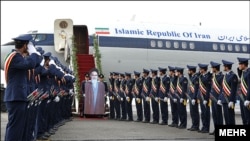On February 1, 1979, Ayatollah Ruhollah Khomeini -- the leader of Iran’s 1979 Islamic Revolution -- returned triumphantly to Tehran on an Air France flight from Paris after 14 years in exile.
Now, 33 years later, that return was reenacted in a bizarre ceremony that saw guards carrying a giant cardboard cutout of Khomeini down the stairs of a passenger plane and a waiting crowd paying their respects to "him."
Iranians have been faced with many unusual and absurd events in the past three decades of the rule of the clerics. The February 1 ceremony, however, may have topped them all.
A series of pictures posted by the semi-official Mehr news agency shows two solemn looking guards carrying a cardboard Khomeini as others give the serious-looking, white-bearded cleric a military salute. A marching band is seen playing music in the background.
Another cardboard Khomeini -- this one smiling and seated -- popped up at a ceremony attended by Education Minister Hamid Reza Haj Babayi and other officials to mark the ayatollah's return to the Refah School, where he set up his headquarters 33 years ago. This cardboard Khomeini sat there while the others -- some looking a bit uncomfortable next to him -- drank tea and chatted.
The ceremonies with the cardboard Khomeini were aimed at glorifying an important moment in Iran’s modern history. But they appear to have had the opposite effect, producing several jokes and mocking comments among Iranians.
Upon returning to Tehran, Khomeini was asked by a foreign reporter how he felt about coming back to his homeland after so many years. He famously replied, “Nothing.”
One joke making the rounds of social media parodies that well-known exchange:
Khomeini’s cardboard cutout arrived in a very different Iran than the one the real Khomeini promised Iranians. He talked of freedom and justice, but the gap between the rich and poor has been widening and the country is frequently criticized by international human rights groups for its repressive policies.
The revolutionary fervor is long gone amid widespread disillusionment.
More than three decades after the 1979 revolution, Iran has repressed many of the children and founding fathers of the revolution with whom Khomeini helped establish the Islamic state.
They include Khomeini’s protege, former prime minister turned opposition leader Mir Hossein Musavi, who has been under house arrest since last February. Reformist cleric and opposition leader Mehdi Karrubi, one of the founding fathers of the revolution, is also under house arrest.
Former President Akbar Hashemi Rafsanjani has been isolated and sidelined because of his rivalry with President Mahmud Ahmadinejad and his criticism of the 2009 postelection crackdown.
Some of Khomeini’s relatives have also come under pressure over their support for the opposition movement.
A Photoshopped picture of Khomeini's cardboard cutout making the rounds on the Internet alludes to the present-day situation. It shows the seated Khomeini saying to officials next to him:
A man in Tehran told RFE/RL that the cardboard Khomeini ceremonies are a “huge charade.”
"Is this how [Iranian authorities] want to regain legitimacy? By creating a cardboard idol?” he asked.
-- Golnaz Esfandiari
Now, 33 years later, that return was reenacted in a bizarre ceremony that saw guards carrying a giant cardboard cutout of Khomeini down the stairs of a passenger plane and a waiting crowd paying their respects to "him."
Iranians have been faced with many unusual and absurd events in the past three decades of the rule of the clerics. The February 1 ceremony, however, may have topped them all.
A series of pictures posted by the semi-official Mehr news agency shows two solemn looking guards carrying a cardboard Khomeini as others give the serious-looking, white-bearded cleric a military salute. A marching band is seen playing music in the background.
Another cardboard Khomeini -- this one smiling and seated -- popped up at a ceremony attended by Education Minister Hamid Reza Haj Babayi and other officials to mark the ayatollah's return to the Refah School, where he set up his headquarters 33 years ago. This cardboard Khomeini sat there while the others -- some looking a bit uncomfortable next to him -- drank tea and chatted.
The ceremonies with the cardboard Khomeini were aimed at glorifying an important moment in Iran’s modern history. But they appear to have had the opposite effect, producing several jokes and mocking comments among Iranians.
Upon returning to Tehran, Khomeini was asked by a foreign reporter how he felt about coming back to his homeland after so many years. He famously replied, “Nothing.”
One joke making the rounds of social media parodies that well-known exchange:
Khomeini’s cardboard cutout is asked how he feels about returning to Iran. "Khomeini was a human and even he didn’t have any feelings. I’m just a cardboard cutout," he says.
Khomeini’s cardboard cutout arrived in a very different Iran than the one the real Khomeini promised Iranians. He talked of freedom and justice, but the gap between the rich and poor has been widening and the country is frequently criticized by international human rights groups for its repressive policies.
The revolutionary fervor is long gone amid widespread disillusionment.
More than three decades after the 1979 revolution, Iran has repressed many of the children and founding fathers of the revolution with whom Khomeini helped establish the Islamic state.
They include Khomeini’s protege, former prime minister turned opposition leader Mir Hossein Musavi, who has been under house arrest since last February. Reformist cleric and opposition leader Mehdi Karrubi, one of the founding fathers of the revolution, is also under house arrest.
Former President Akbar Hashemi Rafsanjani has been isolated and sidelined because of his rivalry with President Mahmud Ahmadinejad and his criticism of the 2009 postelection crackdown.
Some of Khomeini’s relatives have also come under pressure over their support for the opposition movement.
A Photoshopped picture of Khomeini's cardboard cutout making the rounds on the Internet alludes to the present-day situation. It shows the seated Khomeini saying to officials next to him:
"Hi, guys. Very nice meeting you. But have you seen Akbar, by any chance? Hashemi?" Those sitting next to him pretend they have no idea who "Akbar" is and try to change the subject. “We don’t have any Akbar here.” They add: “We also don’t have [Mir Hossein Musavi] and [Mehdi Karrubi]. Let's change the topic. How are you?”
A man in Tehran told RFE/RL that the cardboard Khomeini ceremonies are a “huge charade.”
"Is this how [Iranian authorities] want to regain legitimacy? By creating a cardboard idol?” he asked.
-- Golnaz Esfandiari








